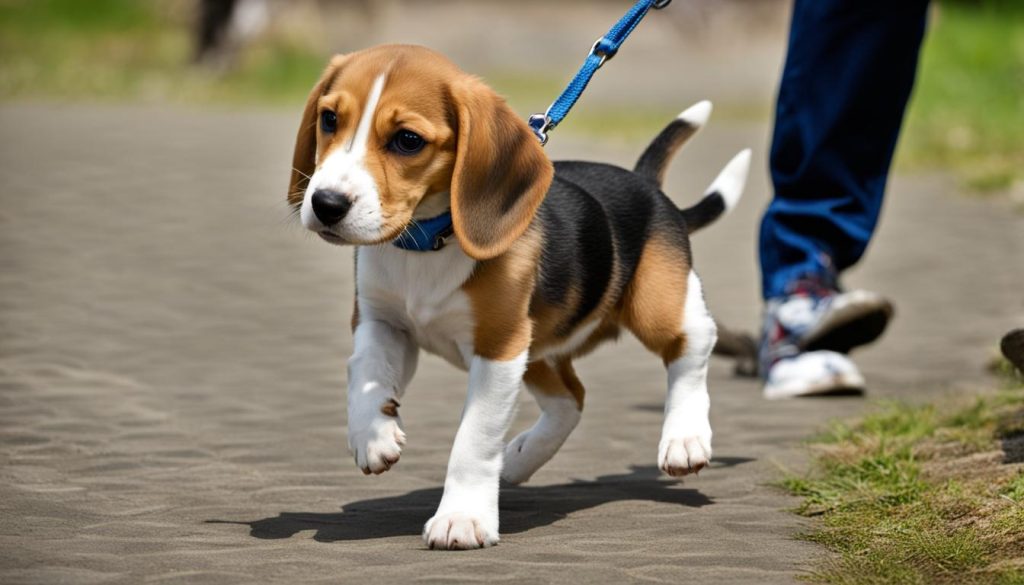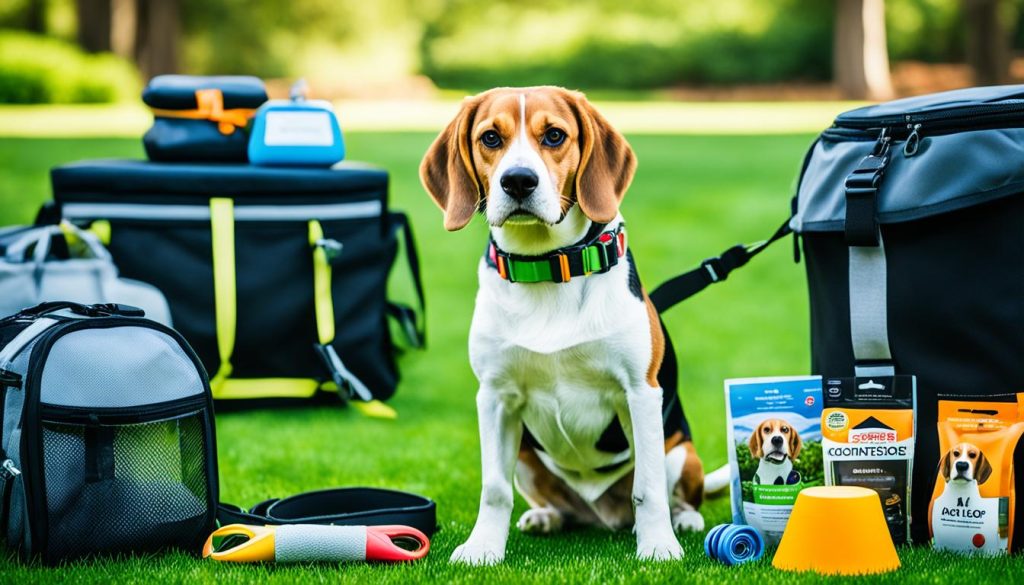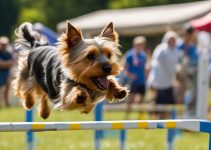Welcome to my guide on effective Beagle training! Beagles are unique and fascinating dogs known for their incredible sense of smell. If you’re a proud Beagle owner looking to train your furry friend, you’ve come to the right place. In this article, I will share essential tips and techniques to help you successfully train your Beagle, from obedience and behavior training to potty and crate training.
When it comes to Beagle training, consistency is key. By establishing regular training sessions, providing positive reinforcement, and setting clear boundaries, you can effectively communicate with your Beagle and shape their behavior. Training a Beagle requires patience and dedication, but the results are well worth the effort.
Discover Beagle Training Techniques
- Establish a consistent training routine to keep your Beagle engaged and focused.
- Use positive reinforcement techniques, such as treats and praise, to reward desired behaviors.
- Address common behavior issues, such as barking problems and leash pulling, with patience and training.
- Consider the Beagle’s unique personality and traits when tackling advanced training challenges.
- Maintain training consistency to ensure long-term success and a well-behaved, happy Beagle.
Beagle Training Essentials
To effectively perform Beagle training, it is important to focus on three key areas: crate training, potty training, and teaching basic commands. By giving proper attention to these essentials, you can establish a strong foundation for your Beagle’s training journey.
Crate Training for Beagles
Crate training is an essential part of Beagle training. It provides a safe and secure space for your Beagle and helps with housebreaking. Introduce your Beagle to the crate gradually, making it a comfortable and positive environment. Use treats and rewards to encourage your Beagle to enter and spend time in the crate. Remember to never use the crate as a form of punishment, as it should be a positive and welcoming space for your furry friend.
Potty Training a Beagle
Potty training is crucial for a harmonious living environment. Establish a consistent routine by taking your Beagle to the designated potty area regularly. When your Beagle eliminates in the correct spot, praise and reward them immediately to reinforce the desired behavior. Consistency is key during this training process, so be patient and persistent to achieve success.
Teaching Basic Commands to a Beagle
Teaching basic commands such as sit, stay, and come is essential for your Beagle’s obedience and safety. Start with one command at a time and use positive reinforcement techniques, such as treats or verbal praise, to motivate and reward your Beagle for following the commands. Consistency and repetition are vital for your Beagle to master these basic commands.
Remember, training a Beagle requires patience, consistency, and positive reinforcement. By focusing on crate training, potty training, and teaching basic commands, you are setting the stage for a well-behaved and happy Beagle. In the next section, we will explore the importance of establishing a training routine to ensure long-term success.
Establishing a Training Routine
Consistency is key when it comes to beagle training. By establishing a solid training routine, you can help your beagle become a well-behaved and obedient companion. Here are some essential steps to follow:
- Plan Regular Training Sessions: Set aside dedicated time for training your beagle. Consistency is crucial, so aim for at least 2-3 short training sessions per day.
- Keep Sessions Short and Focused: Beagles have a shorter attention span, so keep training sessions to around 10-15 minutes each. Focus on one command or behavior at a time to avoid overwhelming your furry friend.
- Incorporate Positive Reinforcement Techniques: Positive reinforcement is a highly effective training method for beagles. Use treats, praise, and affection to reward your beagle for good behavior. This encourages them to repeat the desired actions.
- Integrate Training into Daily Activities: Training shouldn’t be limited to formal sessions. Look for opportunities to reinforce commands and behaviors throughout the day. For example, ask your beagle to sit before mealtime or to wait patiently before going for a walk.
- Monitor and Track Progress: Keep a record of your beagle’s training progress. Note down the commands they’ve mastered and any challenges they’re still working on. Monitoring progress allows you to tailor your training approach and celebrate achievements.
Remember, consistency and positive reinforcement are the building blocks of an effective training routine for your beagle. Be patient, stay dedicated, and enjoy the journey of training your furry friend.
Positive Reinforcement Techniques
When it comes to training Beagles, positive reinforcement techniques can be highly effective. These techniques, such as treat-based rewards and clicker training, not only motivate the Beagle but also help them learn quickly and happily.
Treat-based rewards involve using treats, praise, or playtime as a reward when the Beagle exhibits the desired behavior. By associating the behavior with a positive outcome, the Beagle is more likely to repeat it. Treat-based rewards are especially beneficial for teaching basic commands, potty and crate training, and promoting positive behavior.
Clicker training is another popular positive reinforcement technique that works well for Beagles. It involves using a small device called a clicker, which makes a distinct clicking sound. The clicker is followed by a treat to mark the desired behavior. Over time, the Beagle learns to associate the clicker sound with a reward and will perform the desired behavior to hear the click. Clicker training can be used to teach new commands, improve behavior, and also helps in building a strong bond with the Beagle.
Both treat-based rewards and clicker training are effective because they tap into the Beagle’s natural instincts and desire for rewards. These techniques provide clear and immediate feedback, which helps the Beagle understand what is expected of them and what behavior will lead to a positive outcome.
By incorporating positive reinforcement techniques into your Beagle’s training routine, you can create a positive and enjoyable learning experience for your furry friend. It’s important to remember to be consistent, patient, and use rewards that are highly motivating for your Beagle. This will not only help them learn quickly but also strengthen the bond between you and your pet.
Addressing Common Behavior Issues
Barking problems and leash pulling are common behavior issues that Beagle owners may face. If your Beagle is exhibiting excessive barking or pulling on the leash, it’s important to address these issues using effective techniques.
Addressing Barking Problems
To address barking problems in Beagles, positive reinforcement techniques can be highly effective. One technique is to reward your Beagle for barking on command. This helps them associate barking with a specific cue and can give you better control over their barking behavior. Additionally, identifying the triggers of their barking, such as certain sounds or sights, can help you address the root cause of the problem.
Regular activities and mental/physical stimulation are also important in preventing excessive barking. Make sure your Beagle receives enough exercise and mental stimulation to keep them physically and mentally satisfied. This can help reduce boredom, which is often a contributing factor to excessive barking.
Addressing Leash Pulling
Leash pulling is another common behavior issue in Beagles. To address this problem, positive reinforcement training methods should be used. The goal is to teach your Beagle to walk on a loose leash without pulling. Start by rewarding your Beagle for walking calmly beside you and gradually increase the duration of their loose leash behavior.
Consistency and patience are key in addressing leash pulling. Beagles are naturally curious and may be prone to pulling when they are eager to explore their surroundings. With consistent training and positive reinforcement, you can teach your Beagle to walk politely on a leash.

Advanced Training Challenges
When it comes to advanced training challenges with Beagles, it’s important to consider their unique personality and traits. Beagles are intelligent and independent dogs with a strong sense of smell, which can make advanced training more challenging but also rewarding.
To overcome these challenges, effective techniques can be implemented. One approach is teaching complex commands and tasks that challenge the Beagle’s skills and intelligence. This not only keeps them mentally stimulated but also helps them develop their problem-solving abilities.
Addressing specific behavioral challenges is another crucial aspect of advanced Beagle training. Beagles can be stubborn and independent, so it’s important to use positive reinforcement and consistency to encourage desired behaviors and discourage unwanted ones. Building a strong bond through trust and respect will significantly improve training outcomes.
Utilizing advanced training techniques like agility and scent work can also be beneficial. These activities provide mental stimulation, as well as physical exercise, which is essential for keeping Beagles focused and engaged during training sessions.
Maintaining Training Consistency
To ensure that your Beagle retains what they’ve learned and continues to behave well, maintaining training consistency is crucial. By following a few important principles, you can establish a solid foundation for your dog’s training journey.
Setting Clear Boundaries
Setting clear boundaries is essential in creating a structured and disciplined training environment for your Beagle. Consistency in enforcing rules and expectations will help your dog understand what behaviors are acceptable and what are not. This clarity provides a sense of security and helps your Beagle develop a strong understanding of their place in the family hierarchy.
Using Positive Reinforcement
Positive reinforcement is a highly effective technique in Beagle training. By rewarding desired behaviors with praise, treats, or playtime, you can motivate and reinforce positive actions. Your Beagle will associate these rewards with good behavior and will be more inclined to repeat those behaviors in the future.
Correcting Behavior When Necessary
While positive reinforcement is important, it’s equally crucial to correct unwanted behaviors to ensure your Beagle’s training progress. When addressing inappropriate behaviors, it’s essential to intervene calmly and assertively. Redirect your Beagle’s attention and guide them towards the desired behavior using positive reinforcement techniques.
Avoiding Harsh Punishments
Harsh punishments can be detrimental to the training process and the relationship between you and your Beagle. Instead, focus on positive reinforcement and redirection to correct unwanted behaviors. By maintaining a gentle approach, you will preserve the trust and bond between you and your furry friend.
Starting Training Early
Early training is key to shaping your Beagle’s behavior and ensuring a smooth training journey. Start training as soon as you bring your Beagle home, focusing on basic commands and house manners. The earlier you establish a routine and set expectations, the easier it will be for your Beagle to adapt and learn.
Remember, maintaining training consistency is a lifelong commitment. By setting clear boundaries, using positive reinforcement, correcting behavior when necessary, avoiding harsh punishments, and starting training early, you can help your Beagle become a well-behaved and happy member of your family.

Conclusion
Effective Beagle training requires a consistent training routine, positive reinforcement techniques, and addressing common behavior issues. By focusing on crate training, potty training, and teaching basic commands, Beagle owners can raise well-behaved and happy dogs. The key is to establish clear boundaries and provide consistent guidance to help the Beagle understand what is expected of them.
Addressing advanced training challenges may require a tailored approach considering the Beagle’s unique personality and traits. Their intelligence and independence can be harnessed through teaching complex commands and tasks. Providing mental stimulation and physical exercise is also important to keep the Beagle engaged during training sessions.
Maintaining Beagle training consistency is crucial for long-term success. By using positive reinforcement techniques and avoiding harsh punishments, the Beagle will learn to associate training with positive experiences. Starting training early and being patient with the process will ensure a strong bond and mutual trust between the owner and the Beagle. With dedication and a consistent training routine, Beagle training can be a rewarding experience, resulting in a well-behaved and happy companion.
FAQ
What are some effective techniques for training a Beagle?
To effectively train a Beagle, it is important to establish consistent practices, provide positive reinforcement, and set clear boundaries. Crate training, potty training, and teaching basic commands are key areas to focus on.
How can I crate train my Beagle?
Crate training provides a safe and secure space for the Beagle and helps with housebreaking. It involves gradually introducing the crate, making it comfortable with bedding and toys, and using positive reinforcement to encourage the Beagle to spend time in the crate.
What is the best way to potty train a Beagle?
Potty training involves establishing a routine, taking the Beagle to the designated potty area regularly, and praising and rewarding them for eliminating in the right spot. Consistency and positive reinforcement are key to successful potty training.
How can I teach my Beagle basic commands?
Teaching basic commands such as sit, stay, and come is essential for the Beagle’s obedience and safety. Using positive reinforcement techniques, such as treats and praise, can help motivate the Beagle to learn and obey these commands.
How important is establishing a training routine for my Beagle?
Establishing a consistent training routine is crucial for success. This involves planning regular training sessions, keeping them short and consistent, incorporating positive reinforcement techniques, integrating training into daily activities, and monitoring the Beagle’s progress.
What are some positive reinforcement techniques I can use during training?
Positive reinforcement techniques, such as treat-based rewards and clicker training, can be highly effective in training a Beagle. Treat-based rewards involve using treats, praise, or playtime as a reward when the Beagle exhibits the desired behavior. Clicker training uses a clicking sound followed by a treat to mark the desired behavior.
How can I address common behavior issues like barking and leash pulling?
To address barking problems, positive reinforcement techniques such as rewarding the Beagle for barking on command and identifying triggers can be effective. To address leash pulling, positive reinforcement training methods should be used to teach the Beagle to walk on a loose leash.
What are some advanced training challenges with Beagles?
Beagles’ unique personality and traits, including their intelligence, independence, and strong sense of smell, can present challenges in advanced training. Effective techniques include teaching complex commands and tasks, addressing specific behavioral challenges, and utilizing advanced training techniques like agility and scent work.
How can I maintain training consistency with my Beagle?
Maintaining training consistency is crucial for ensuring a Beagle retains what they’ve learned and continues to behave well. This involves setting clear boundaries, using positive reinforcement, correcting behavior when necessary, avoiding harsh punishments, and starting training as early as possible.






